Key takeaways:
- Understanding the event’s goals and the speaker’s emotional connection to the audience is crucial for selecting the right speaker.
- Creating a comprehensive checklist with input from the speaker helps anticipate needs and ensure successful event logistics.
- Scheduling rehearsals and dry runs significantly boosts speaker confidence and enhances presentation quality.
- Providing constructive feedback that balances positivity and specificity fosters growth and encourages self-reflection in speakers.
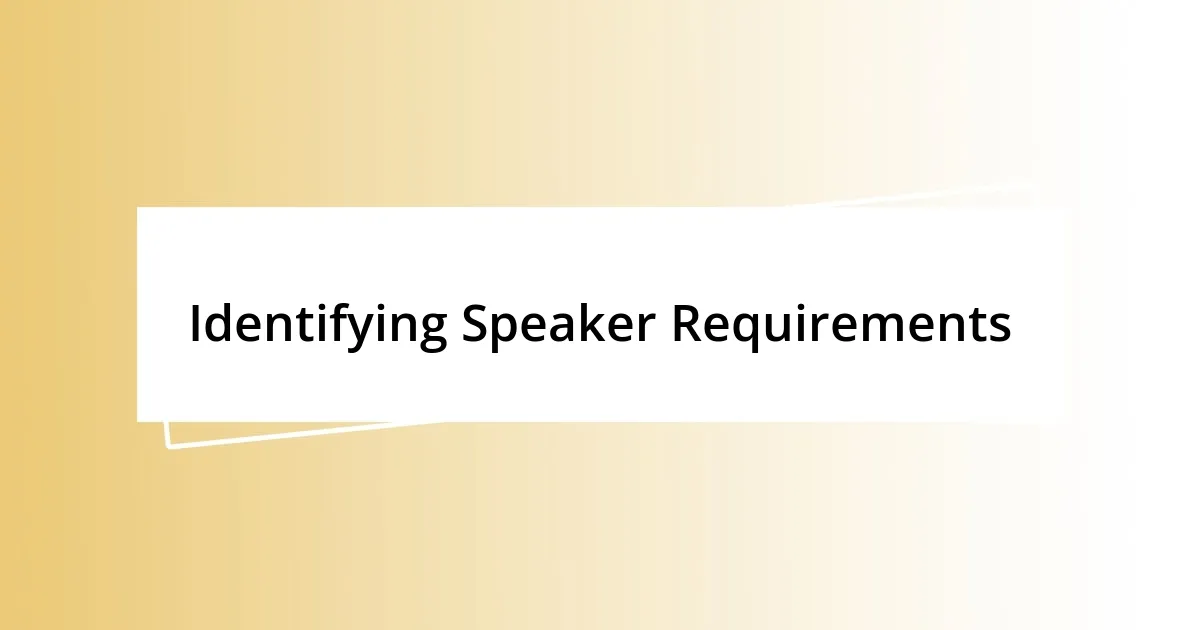
Identifying Speaker Requirements
When identifying speaker requirements, I find it essential to start by understanding the specific goals of the event. What message are you hoping to convey? In my experience, clarity in objectives helps indicate the type of speaker needed—whether it’s a technical expert, a motivational leader, or someone who can weave personal stories into a larger narrative.
I remember a time when I was tasked with organizing a conference and, after meeting with the client, discovered they wanted not just expertise but also a speaker who could connect emotionally with the audience. This insight guided my search and led to a perfect match. I realized that the emotional tone of the speaker could significantly influence audience engagement, so it’s crucial to ask probing questions during your initial discussions.
Moreover, logistics shouldn’t be overlooked. What is the audience size? What is the available technology? I once worked with a speaker who insisted on using specific equipment that wasn’t provided, which created a bit of a scramble last minute. By pinpointing these requirements early on, you ensure a smoother event and a more confident presenter. It’s all about anticipating needs and setting everyone up for success!
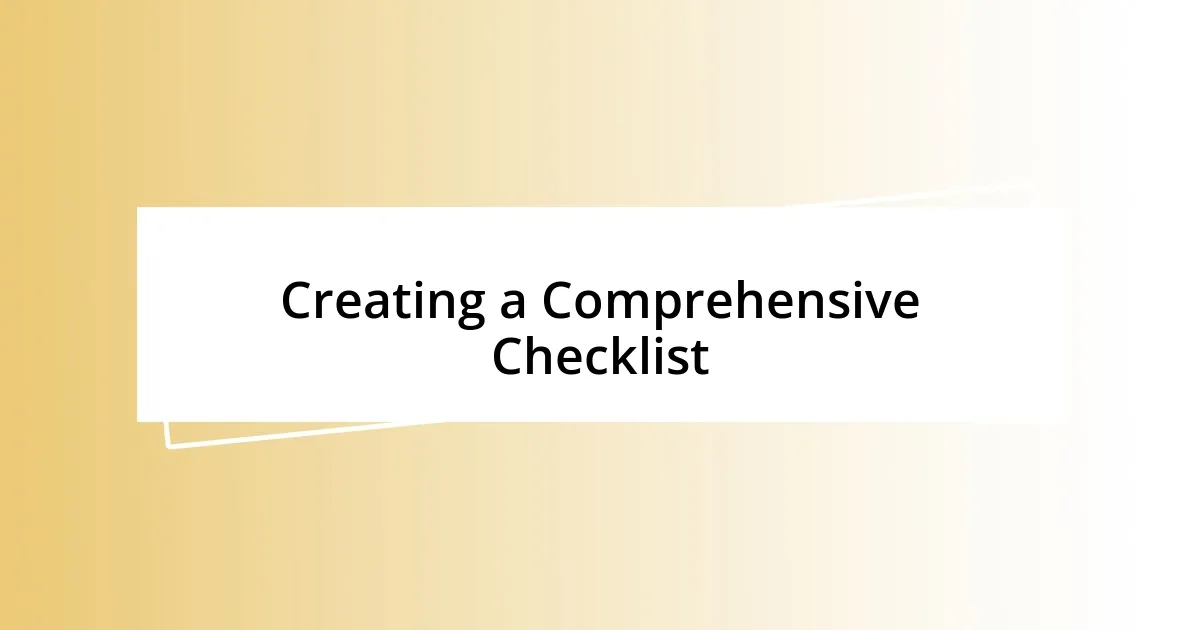
Creating a Comprehensive Checklist
Creating a comprehensive checklist is like crafting a roadmap for success. I often start by breaking down the essentials into categories such as logistics, content, and speaker needs. One time, I overlooked checking the audio-visual equipment compatibility, which led to a tense moment right before a keynote speech. That taught me the importance of comprehensive planning, as a thorough checklist can truly save the day.
Additionally, I find it helpful to involve the speaker in the checklist creation process. When I collaborated with a speaker on a particular checklist, we uncovered some unique requirements and preferences that I hadn’t considered. It created a sense of partnership; I could see how much it meant to them to have their voice heard, and the end result was a more tailored presentation that resonated with the audience.
Lastly, I’ve learned the value of revisiting and updating the checklist as the event approaches. For instance, I remember a workshop where new participants were added last minute, altering the dynamic completely. Adjusting the checklist to include considerations for new audience members transformed what could have been a chaotic situation into a productive, engaging experience. This process allows for flexibility and fosters confidence, ensuring that each step is accounted for and that everyone is on the same page.
| Checklist Category | Details |
|---|---|
| Logistics | Venue info, equipment, travel arrangements |
| Content | Speaker topics, audience engagement strategies |
| Speaker Needs | Technical requirements, personal preferences |
| Audience Insights | Demographics, interests, feedback mechanisms |

Scheduling Rehearsals and Dry Runs
Scheduling rehearsals and dry runs is a crucial step in the preparation process. I’ve often found that nothing beats the feeling of a well-executed rehearsal. There was one time when I organized a keynote address for a non-profit. The speaker rehearsed in the actual venue, which allowed them to adapt to the space and test out the microphone. The relief in their eyes when they realized they could effectively use their gestures and connect with the audience was priceless. It’s these moments that highlight the power of practice.
I recommend holding at least one dry run for every major presentation. To ensure things run smoothly, I like to:
- Choose a suitable location: Use the actual venue if possible, or a similar environment.
- Incorporate technical checks: Test all equipment (microphones, projectors) ahead of time.
- Simulate a real audience: Invite colleagues or friends to provide feedback and simulate the energy of an actual event.
- Encourage feedback: Create a comfortable space for speakers to express their concerns and receive constructive feedback.
- Record the run: Capturing the rehearsal can be invaluable for reflection and improvement.
The dedication I’ve seen from speakers during rehearsals often translates into a more polished and confident performance on the actual day. The more prepared they feel, the more they can focus on connecting with the audience and delivering their message effectively.
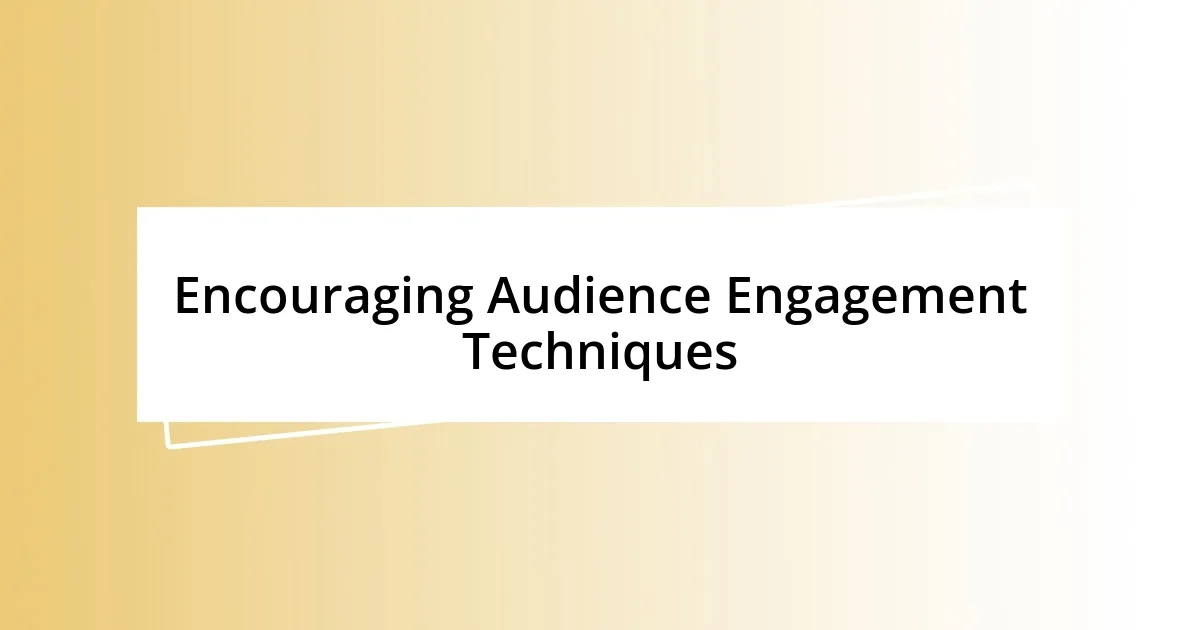
Encouraging Audience Engagement Techniques
Encouraging audience engagement isn’t just about delivering content; it’s about creating a dialogue. When I recently attended a conference, the speaker opened with a question directly related to audience experiences. It was fascinating to see hands shoot up in response! This engagement technique not only made the session feel interactive but also built a sense of community among attendees. I couldn’t help but think how much more connected the audience felt when invited to share their thoughts.
I’ve also found that incorporating storytelling can significantly enhance engagement. For example, during a workshop, I shared a personal challenge I faced related to the session’s theme. The vulnerability I displayed resonated with many participants, leading to heartfelt discussions afterward. It struck me how powerful storytelling can be in breaking barriers. It invites people to resonate with personal experiences, making the content memorable.
Utilizing tools like live polls or Q&A sessions can further boost audience involvement. I remember hosting a webinar where we employed a live poll. Participants eagerly participated, shaping the direction of the discussion in real-time. It was electrifying to witness! These interactive elements not only keep energy levels high but also ensure that the audience feels their contributions are valued. How do you usually gauge audience interest during your sessions? It’s a crucial question that each speaker should consider, as fostering this kind of engagement lays the groundwork for a richer learning experience.
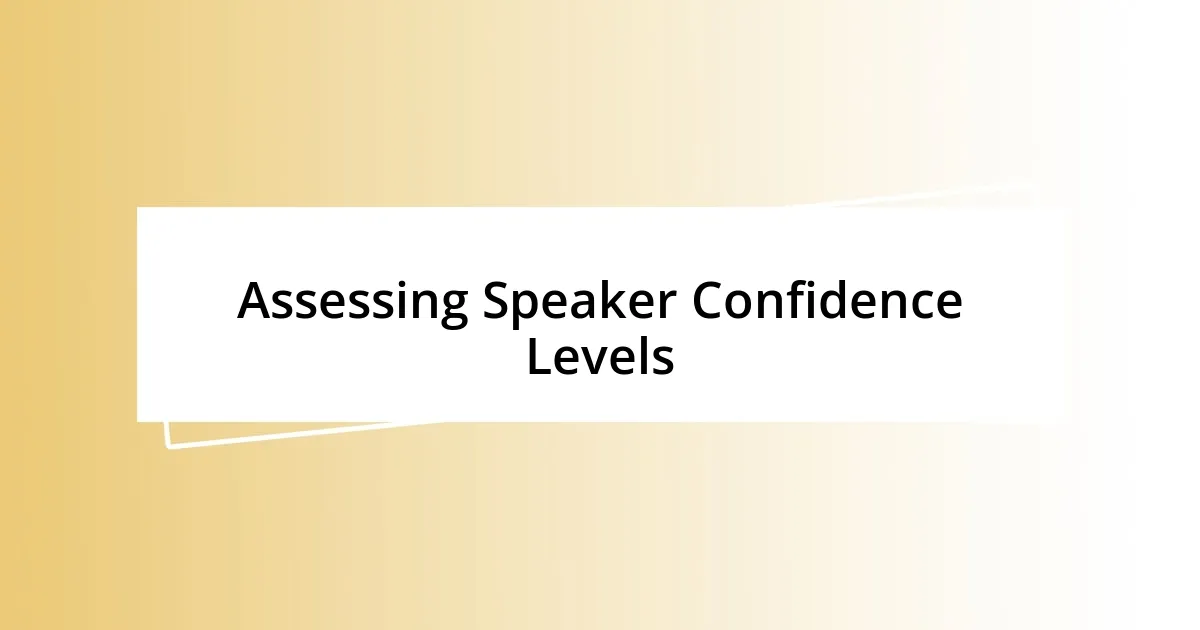
Assessing Speaker Confidence Levels
Assessing speaker confidence levels is a multifaceted process that starts with observation. I’ve learned to pay close attention to body language; a confident speaker typically maintains eye contact and uses open gestures. There was one time I noticed a speaker fidgeting with their notes, which instantly told me they were unsure. In those moments, I make it a point to ask them how they feel about their material and whether there are specific sections that unsettle them.
Building rapport is another effective strategy. During a recent workshop, I took a few extra minutes to chat with a presenter before their turn. We discussed their journey and the message they wanted to convey, which not only eased their nerves but also ignited a spark that translated into a dynamic presentation shortly after. I believe having this kind of personal interaction can reveal insights into their confidence, reassuring them that they are well-prepared and capable.
Finally, I utilize practice sessions to serve as both a barometer and a booster for their confidence. Just last week, after a series of rehearsals, I saw a dramatic transformation in one speaker’s demeanor—from tentative to poised and passionate. It was as if they had stepped into a new version of themselves! Have you ever witnessed such a shift? It’s a powerful reminder that confidence can be cultivated through preparation and support. Each speaker has unique traits, but with the right encouragement, they can unlock their full potential.
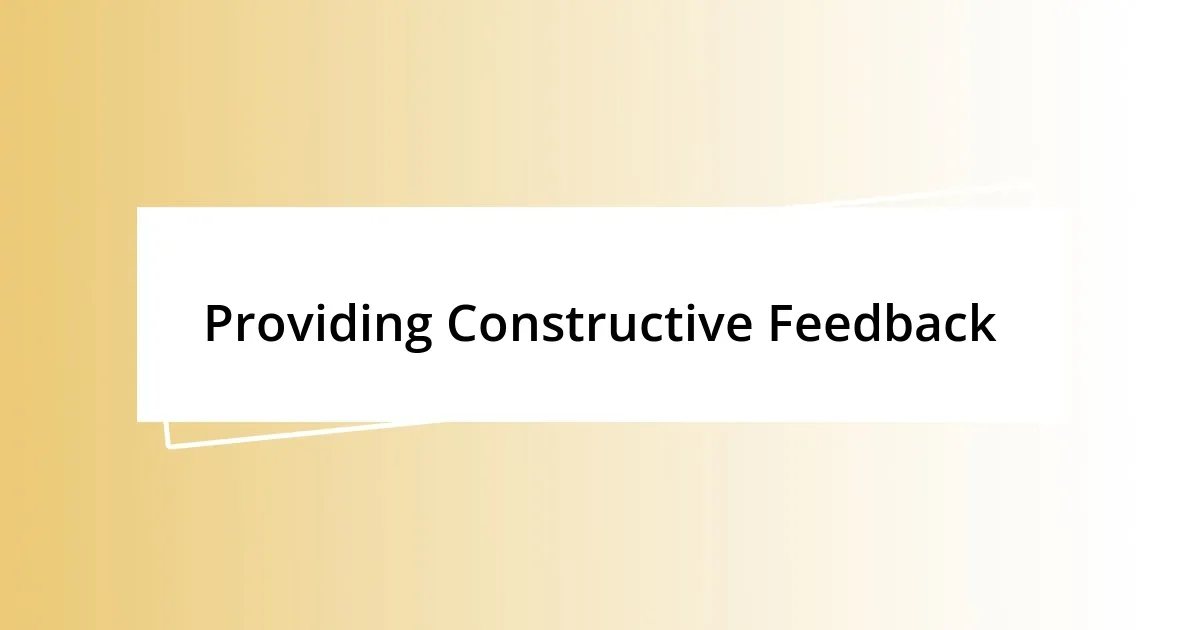
Providing Constructive Feedback
Providing constructive feedback is all about striking a balance between encouragement and improvement. I vividly remember a time when I attended a peer review session, where I noticed a colleague hesitated to share their thoughts on a presenter’s performance. When it was my turn, I emphasized the positive aspects first, mentioning how the speaker’s passion was palpable. I framed my suggestions within that positivity, explaining how refining their transitions could make their message clearer. This approach not only eased the presenter’s nerves but also highlighted the value of growth rather than focusing solely on what needed fixing.
I’ve learned that specificity matters when giving feedback. One evening, after a presentation, I relayed exactly what I appreciated about the speaker’s examples: their relatability was spot-on. However, I also pointed out that one story seemed to fall flat, likely because it wasn’t as connected to the audience’s experiences. By doing this, I ensured that my feedback felt grounded and constructive, making it easier for them to see the practical application of my words. Have you ever received vague criticism? It leaves you feeling uncertain. Specific feedback clarifies what works and what doesn’t, creating a roadmap for improvement.
Lastly, I find it crucial to invite self-reflection. I often ask speakers how they felt about their delivery and if anything surprised them during the presentation. This approach encourages them to evaluate their own performance critically. In one memorable instance, a speaker expressed surprise at how warmly the audience reacted, which led to a humbling realization about the power of genuine connection. It’s fascinating how opening up this dialogue not only fosters personal growth but also empowers speakers to actively participate in their development journey. Isn’t it rewarding when feedback leads to such breakthroughs?
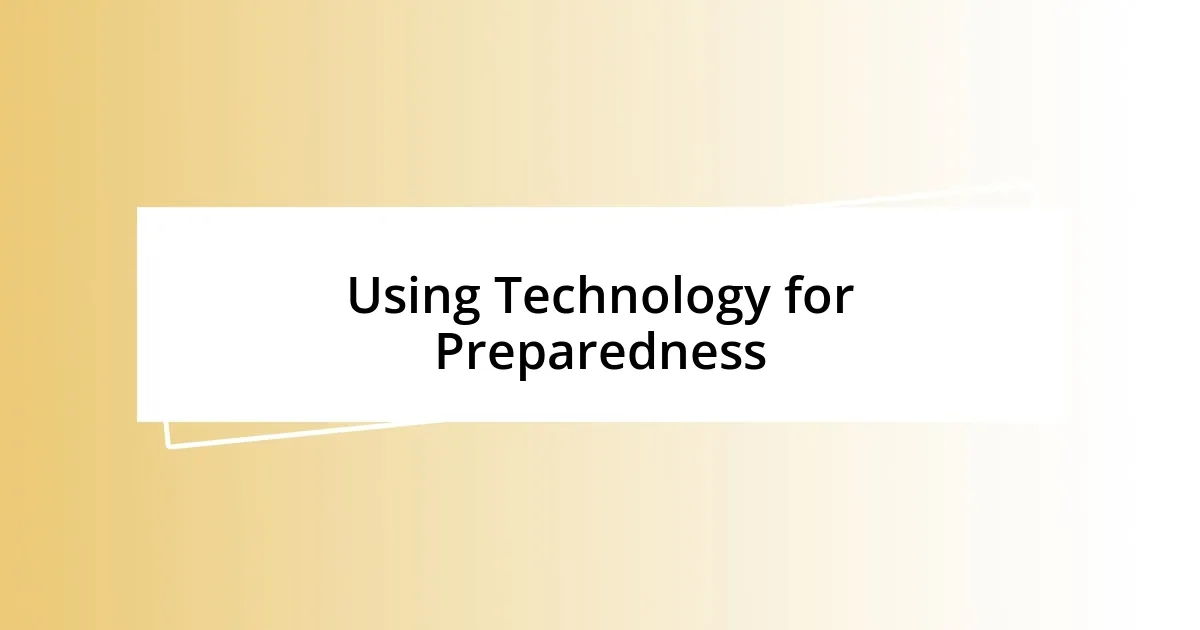
Using Technology for Preparedness
Using technology to ensure speaker preparedness can be a game changer. I recently experimented with recording rehearsal sessions on my phone. Watching the playback allowed both the speaker and me to identify areas that needed tightening, especially in pacing. It’s amazing how a simple video can highlight nuances, like a lingering pause or an overwhelming reliance on notes. Have you ever caught something unexpected when reviewing a recording? It’s often those little details that can make a significant difference.
Another tool I’ve found invaluable is presentation software that includes analytics. During a recent webinar, I used audience engagement metrics to gauge the effectiveness of a speaker’s delivery. It was thrilling to see their surprise when they learned which parts resonated most with viewers. This data not only validated their strengths but also helped pinpoint sections needing more clarity. Isn’t it empowering to back your feedback with solid evidence? This combination of technology and personal insight can truly enhance the overall preparedness.
Lastly, I embrace collaborative platforms for shared feedback during the preparation process. I recall when a team of presenters used a shared document to compile their thoughts, allowing them to critique each other’s ideas in real-time. The excitement was palpable as they built off each other’s suggestions, creating a stronger narrative together. It’s remarkable how technology encourages teamwork, making the preparation phase feel less isolating. Have you noticed how collaboration can spark creativity? It’s a beautiful reminder of how interconnectedness strengthens our capabilities.












